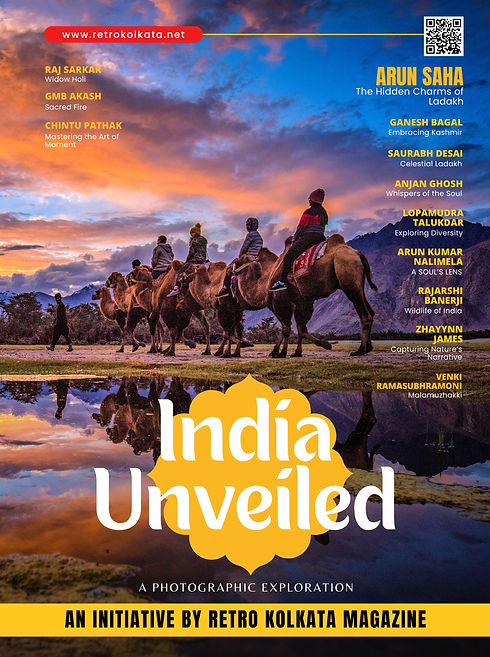
Conceptualizing a shoot is the most important part of a shoot. That gives us an objective of exactly what we want to achieve through the photos. Before the shoot, we make sure that the outfit, location and timing of shoot are in sync with each other. Post processing is also done according to the concept.

RK :First of all, thank you for accepting our invitation for an interview as our Guest Photographer. Let's jump into the past. What first attracted you to photography? At what point did you realize that photography is what you wanted to do as a career?
Ankit : Even before I started photography, I always was a keen observer of things around me. I used to observe different expressions and style around me and then when I started photography, I gradually developed a liking for capturing portraits and fashion. It gives me a way to express myself.
RK : What photographers from the past or present have influenced you the most?
Ankit : Rather than specific photographers, I was more influenced by the moody style of portraits. Thanks to social media, I could get inspired by a variety of work across the globe.

RK : Your projects are a collaborative process. Tell us what is like to always be working with new stylists, models, and designers.
Ankit : It’s always great to have an exchange of ideas. When different creative people come together and pitch in with their ideas, we are bound to have some great work. Everyone has their own unique way of looking at things and the photographer plays an important role in binding the ideas together and coming up with the final work that depicts those ideas.

RK : You’ve clearly worked with a wide range of models, what tips can you recommend to people looking to expand their portfolio?
Ankit : There are different dimensions of expanding your portfolio. First, when you work with different models and brands. Second, when you shoot different concepts. I would say shoot as much as possible, with different models. Try doing different concepts with them. The more the variety of concepts are in your portfolio, the better you grow as a photographer and land more shoots.

RK : Tell us what you do to elicit the moods from your subjects that are communicated in your photographs?
Ankit : Mood is really important in photography. The best way to extract the exact mood from your subjects is to make them feel really comfortable. Strike a conversation. Try talking to them about things other than posing and about general things in life. The more at ease the subjects are, the better the expressions turn out.
RK : What type of cameras, lenses and lighting equipment do you use?
Ankit : My first ever DSLR was Canon 600D, which I still have. Currently, I use a Canon 6D and my go-to lenses are Canon 85mm f/1.8 and Sigma 35mm ART f/1.4. I prefer fixed lenses for their sharpness. While I use Godox lighting, I prefer natural light for my portraits.

RK : To you, what are the qualities that make a perfect shot?
Ankit : A perfect shot is something that makes the viewer stop and admire it for a while. A perfect shot has all the bases covered in terms of technicalities but what makes a normal photograph stand apart from the crowd is the mood it generates. A shot should have good lighting, great composition and perfect mood.

RK : From conceptualizing to post processes, how much planning goes into a shoot?
Ankit : Conceptualizing a shoot is the most important part of a shoot. That gives us an objective of exactly what we want to achieve through the photos. Before the shoot, we make sure that the outfit, location and timing of shoot are in sync with each other. Post processing is also done according to the concept.
RK : How important are colors to portray the real sense of an image?
Ankit : If someone has seen my work, they will know my love for colors and how I use them in my portraits. Each color conveys a specific emotion and we have to use them wisely while creating photos.

RK : How would you describe your photographic vision? What kind of feeling do you try and create in your photos?
Ankit : I always try to create photos that evoke emotions in the viewer.
RK : What are the fundamental changes that you think have happened in fashion photography in India, say in the last five years?
Ankit : I think there is a lot of good changes happening in fashion photography as stereotypes are being done away with. Conversations are being created to encourage body positivity and stop body shaming. We can in fact see celebrity designers embracing the cause. Creators and models from the LGBTQ community have also come to the fore and started expressing themselves through outstanding work.

RK : Could you please share Happiest Moment in your Photographic Life?
Ankit : Happiness lies in the small things we do. There have been many small moments in my photographic life, like successful photo shoots and appreciation from my followers and critics.

RK : We (Retro Kolkata) are trying to build one single stage for all the artists, because we believe that artists are the most beautiful creation of God and geographical boundary can never break their unity and harmony. Please say something about our initiative and any special message for your followers.
Ankit : This is a great initiative and kudos to the Retro Kolkata team for providing the creative community a great platform to learn and interact with each other and get inspired. Many thanks for letting me voice my thoughts and I hope this would help other photographers in their creative journey.
Follow Ankit Kumar on Instagram



.png)




















